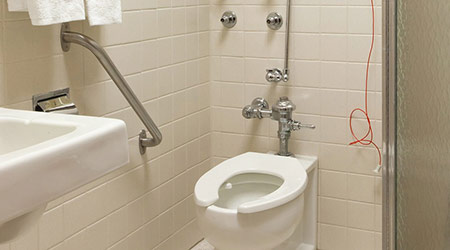When choosing options to update or renovate aging bathrooms, health care facility managers must balance cost and time above all else.
Renovations often require fast turnarounds to allow hospitals to maintain operations without the cost and disruption of full demolition or replacement.
When the University of Maryland Medical Center in Baltimore needed to rehabilitate patient bathrooms quickly and economically in 2017, it turned to Miracle Method Tri-State.
Case study
UMMC contracted with Miracle Method Tri-State to repair and refinish 20 patient bathrooms. The timeline to complete the bathrooms was 3 to 4 days instead of weeks to gut and remodel them.
Miracle Method Tri-State has previously completed extensive refinishing work at hospitals and facilities within the University of Maryland’s Medical System.
Refinishing process
Miracle Method technicians began the process using specially formulated two-step cleaners to remove soap scum, mineral deposits, and body oils from the tile walls, floors, and terrazzo shower pans. Next, technicians repair chipped, cracked, broken, or loose tiles. Chips and cracks in any concrete or terrazzo substrates were also repaired.
Following repair, grout was floated to fill and even out tile grout lines. Once done, the tile was cleaned again and Miracle Method’s MM-4 proprietary bonding agent was applied to ensure a solid bond between the old surface and the new finish.
Without a bonding agent, there is no assurance that new finishes will adhere to the tile. Acid-free MM-4 bonds old and new surfaces together on a molecular level, which ensures long-lasting durability. MM-4 offers superior adhesion on surfaces commonly found in bathrooms including Corian, cultured marble, porcelain, laminate, acrylic, and tile.
Finally, several coats of Miracle Method’s proprietary Natural Accents stone finish coating are applied to the surface with two coats of clear protective coating.
The clear coating ensures long-lasting durability and resists moisture. The coatings, which are non-yellowing and UV-stable, incorporate silver ion technology that resists degradation, discoloration, and odors. They possess antimicrobial qualities that inhibit the growth of harmful bacteria, molds, and mildew.
The entire refinishing process takes 48 to 72 hours, instead of weeks, and is free of the mess, expense, and inconvenience of removing and replacing tile surfaces.
Results
The end result of the refinishing process is a glossy and bright finish with clean and even grout lines. Wall grout is completely sealed. There is no need for regular resealing or maintenance of the grout lines. The new surface is very durable, very easy to clean, chip and scratch resistant.
Advantages of refinishing
The cost of refinishing is much lower than full remodeling. Costs are generally 75 percent lower than that of traditional replacement. Only in cases where the tile backing is wet or loose is refinishing possibly not the best-case scenario. If technicians find that the backing wall is badly deteriorated or unstable, it may require the removal and replacement of the backing and tile before the refinishing process can be completed.
Refinishing can also be a feasible option in other areas of healthcare facilities such as:
• Storage areas
• Glazed block walls
• Concrete floors
• Stall partitions within the bathrooms
• Mechanical rooms
Summing it Up
Healthcare facility managers have an option for bathroom renovation over costly demolition and replacement. Refinishing bathroom surfaces can restore their appearance, provided increased durability, and sanitary conditions at a fraction of a cost of traditional remodeling.
Ryan Gladhill is owner of Miracle Method Tri-State, which is based in Frederick, MD.

 States Move Forward to Better Protect Senior Citizens
States Move Forward to Better Protect Senior Citizens Archer and REDA to Transform Newport Beach Building into Outpatient Center
Archer and REDA to Transform Newport Beach Building into Outpatient Center Sunflower Medical Group Facing Lawsuit Following January Data Breach
Sunflower Medical Group Facing Lawsuit Following January Data Breach Nemours Children's Health Opens New Location in Lake Nona
Nemours Children's Health Opens New Location in Lake Nona Enhancing Safety at Hennepin Healthcare with a Screening System
Enhancing Safety at Hennepin Healthcare with a Screening System